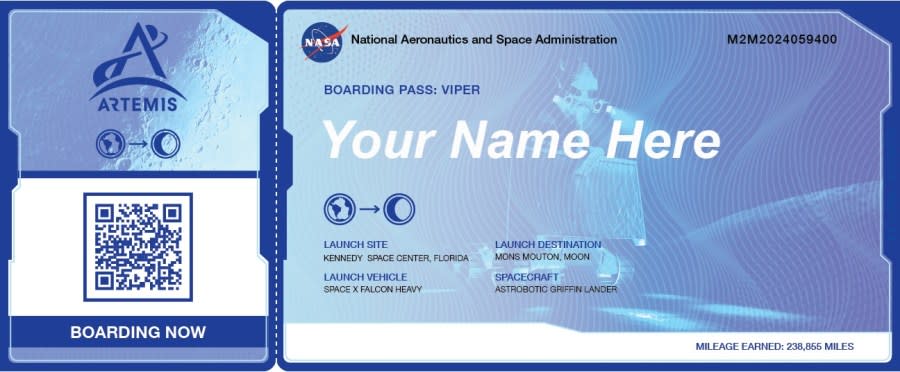Send your name to the Moon aboard NASA’s first robotic Moon rover

SAN DIEGO (FOX 5/KUSI) — The deadline is nearly here to send your name aboard NASA’s first robotic Moon rover as it hunts for frozen water.
The presence of water on the lunar surface was first confirmed in 2020, according to NASA. In 2023, a new map of water distribution on the Moon gave NASA scientists hints about how water could be moving across the Moon’s surface.
Now, in 2024, the federal space agency is inviting people to send their names to the surface of the Moon aboard VIPER, which stands for Volatiles Investigating Polar Exploration Rover, as they gear up for the mission to learn more about water on the Moon.
The deadline to submit your name to travel aboard VIPER is Friday, March 15 at 11:59 p.m. EST (8:59 p.m. PT). Click here to add your name.
‘New’ star to be visible in once-in-a-lifetime event due to rare Nova explosion: NASA
Once the names are all collected, NASA technicians will use an electron beam to stencil the names onto a dime-size microchip that will be attached to the rover.
The website allows participants to create and download a virtual boarding pass to the VIPER mission with their name on it to commemorate the experience.
Participants can also share their enthusiasm for the mission on social media using the hashtag #SendYourName.
NASA launches revolutionary PACE satellite to study Earth’s oceans, changing climate
“With VIPER, we are going to study and explore parts of the Moon’s surface no one has ever been to before – and with this campaign, we are inviting the world to be part of that risky yet rewarding journey,” said Nicola Fox, associate administrator, Science Mission Directorate at NASA Headquarters in Washington. “Just think: Our names will ride along as VIPER navigates across the rugged terrain of the lunar South Pole and gathers valuable data that will help us better understand the history of the Moon and the environment where we plan to send Artemis astronauts.”
VIPER will be traveling to the lunar South Pole in late 2024 in an effort to “unravel the mysteries of the Moon’s water.” Astrobotic Technologies’ Griffin Mission One is scheduled to deliver VIPER to the lunar surface after launching aboard a SpaceX Falcon Heavy from the Cape Canaveral Space Force Station in Florida.
The moon is shrinking, study shows: How it could impact NASA missions
Once on the Moon, VIPER will rely on solar panels and batteries for its 100-day mission to gather data on lunar ice and other possible resources on the Moon.
According to NASA, VIPER will drill and analyze lunar soil from various areas on the Moon at different depths and temperatures. The rover will also head into permanently shadowed craters, some of the coldest spots in the solar system, where ice reserves have endured for billions of years.
NASA streams first-ever high-definition video from deep space
NASA’s VIPER delivery is part of its CLPS (Commercial Lunar Payload Services) initiative under the Artemis program.
This campaign isn’t the first to allow people to send their names to space. Other NASA projects have given tens of millions of people the opportunity to send their names to ride along with, including Artemis I, several Mars spacecraft, and the agency’s upcoming Europa Clipper mission (this author has her name on that particular mission).
Astronaut and USD graduate to lead Crew-8 on 6-month ISS mission
The rover hardware is designed and built by NASA’s Johnson Space Center in Houston, while the instruments are provided by NASA Ames, the agency’s Kennedy Space Center in Florida, and commercial partner Honeybee Robotics in Altadena, California.
NASA says this newest mission is extremely important as it will help us understand possible sources of the lunar polar water, giving us insight into the distribution and origin of water across the solar system.
NASA says the mission will be challenging as the rover will endure extreme temperature conditions, dynamic lighting and complex terrain.
You can learn more about VIPER here.
For the latest news, weather, sports, and streaming video, head to FOX 5 San Diego & KUSI News.


